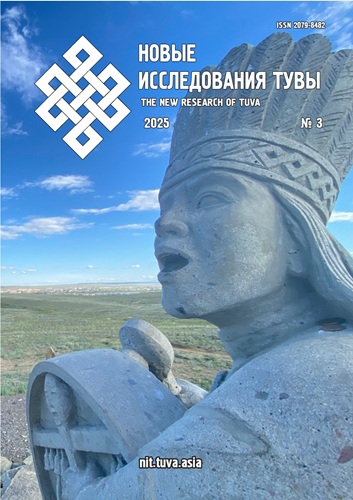Social and Speech Portraits of Social Groups in Tatar Society in the Second Half 19th and Early 20th Centuries: A Value-Axiological and Stylistic Perspective
DOI:
https://doi.org/10.25178/nit.2025.3.13Keywords:
Tatar language; social and speech portrait; axiology; stylistics; social structure; social group; functional development of languageAbstract
This article examines the social and speech portraits of the main social groups within Tatar society in the second half of the 19th and the early 20th centuries from value-axiological and stylistic perspectives.
The relevance of this study stems from the need to address the issue of examining the social foundations of linguistic processes in their historical dimension, particularly the communicative practices of the subjects engaged in social relations. According to the authors, it is within this communicative activity that the mechanisms of language development originate and are set in motion.
The study reveals that during this period, in addition to the peasantry, the social structure of Tatar society included representatives of commercial circles, religious and educational communities, as well as ordinary townspeople. The social and speech characteristics of these groups were largely determined by utilitarian value and axiological orientations. The social and speech portraits of these social groups are marked by the dominance of colloquial style elements, while the use of literary language resources remained minimal.
This observation indicates that, amid the social transformations that occurred within Tatar society during this period, colloquial forms of the Tatar language became the most accessible and widely demanded means of social communication.
References
Azamatov, D. D. (1999) The Orenburg Mohammedan Spiritual Assembly in the Late 18th — 19th centuries. Ufa, Gilem. 194 p. (In Russ.)
Bashirova, I. B. (2008) The Tatar Literary Language at the End of the 19th — Beginning of the 20th Centuries: Genres, Styles, Norm and Variation of Certain Grammatical Categories. Kazan, TȮHSI. 340 p. (In Tatar)
Boiko, B. L. (2008) Principles of Modeling a Speech Portrait of a Speaker of a Socio-Group Dialect. Armiya i obshchestvo, no. 2, pp. 114–121. (In Russ.)
Vinokur, T. G. (1989) The Speech Portrait of the Contemporary Person. In: Filippova, E. V. (comp.), Frolov, I. T. (ed.) Man in the System of Sciences. Moscow, Nauka. 503 p. Pp. 361–370. (In Russ.)
Gabdrafikova, L. R. (2012) Everyday Life of Tatar Students (Shakirds) in the Late 19th — Early 20th Centuries. Izvestiya Altayskogo gosudarstvennogo universiteta, no. 4–1 (76), pp. 56–62. (In Russ.)
Gabdrafikova, L. R. (2015) Tatar Bourgeois Society: Lifestyle in a Time of Change (Second Half of the 19th — Early 20th Century). Kazan, Tatar Book Publishing House. 367 p. (In Russ.)
Zagidullin, I. K., Bagautdinova, K. Z. and Baibulatova, L. F. (2015) The Issue of Muslim Shop Holidays in Petitions by Kazan Tatars in the Late 19th — Early 20th Centuries. Gasyrlar avazy — Ekho vekov, no. 3/4, pp. 47–65. (In Russ.)
Znamensky, P. V. (1910) The Kazan Tatars. Kazan, Printing House of the Imperial University. 67 p. (In Russ.)
Ilyalova, I. I. (1986) The Kamal Theatre. Kazan, Tatar Book Publishing House. 327 p. (In Russ.)
The History of the Tatars from Ancient Times (2013) / ed. by R. Khakimov. Kazan: Institute of History of the Academy of Sciences of the Republic of Tatarstan. Vol. VI: The Formation of the Tatar Nation in the 19th — Early 20th Centuries. 1172 p. (In Russ.)
Karaulov, Y. N. (1987) The Russian Language and the Linguistic Personality. Moscow, Nauka. 264 p. (In Russ.)
Krysin, L. P. (2001) The Modern Russian Intellectual: An Attempt at a Speech Portrait. Russkiy yazyk v nauchnom osveshchenii, no. 1, pp. 90–106. (In Russ.)
Larin, B. A. (1928a) Toward a Linguistic Characterization of the City: Some Preconditions. Izvestiya Leningradskogo gosudarstvennogo pedagogicheskogo instituta im. A. I. Gertsena, vol. 1, pp. 175–185. (In Russ.)
Larin, B. A. (1928b) On the Linguistic Study of the City. In: Shcherba, L. V. (ed.) Russkaya rech’, vol. 3. Leningrad, Academia. 96 p. Pp. 61–74. (In Russ.)
Mirkhayev, R. F. and Minnullin, B. K. (2024) The Socio-Speech Portrait of the Volga Region Tatars in the Second Half of the 19th — First Decade of the 20th Century: Theoretical Basis of the Study. Filologicheskie nauki. Voprosy teorii i praktiki, vol. 17, no. 10, pp. 3505–3509. (In Russ.)
Nikolaeva, T. M. (1991) ‘Sociolinguistic Portrait’ and Methods of Its Description. In: Dmitrieva, O. L. et al. (eds.) The Russian Language and Modernity: Issues and Prospects of Russian Studies. Papers of the All-Union Scientific Conference. Part 2. Moscow, IRYAZ. 242 p. Pp. 69–74. (In Russ.)
Panov, M. V. (1990) History of Russian Literary Pronunciation in the 18th–20th Centuries. Moscow, Nauka. 453 p. (In Russ.)
Polivanov, E. D. (1968) Articles on General Linguistics: Selected Works. Moscow, Nauka. 376 p. (In Russ.)
History of the Tatar Literary Language (13th — Early 20th Century) (2015) : in 3 vol. / Bashirova, I. B., Nuriyeva, F. Sh., Kadyirova, E. Kh., ed. by Khisamova, F. M. Kazan, TȮHSI. Vol. I: Phonetics. Graphics: Written Traditions, Norm and Variability. 696 p. (In Tatar)
History of the Tatar Literary Language (13th — Early 20th Century) (2017) : in 3 vol. / Bashirova, I. B., Nuriyeva, F. Sh., Kadyirova, E. Kh., ed. by Khisamova, F. M. Kazan, TȮHSI. Kazan, TȮHSI. Vol. II: Morphology. Structural-Substantial Specificity and Functional-Stylistic Possibilities of Grammatical Categories: Written Traditions, Norm and Variation. 888 p. (In Tatar)
History of the Tatar Literary Language (13th — Early 20th Century) (2019). Bashirova, I. B., Valieva, M. Z., Gainullina, G. F., Kuzmina, Kh. Kh., ed. by Bayazitova, F. S. Kazan, TȮHSI. Vol. III. Part 1: Lexis. Invariant-Paradigmatic Nature and Contextual-Syntagmatic Potential of Lexico-Semantic Categories: Written Traditions, Norm and Variation. 528 p. (In Tatar)
History of the Tatar Literary Language (13th — Early 20th Century) (2020) / Bashirova, I. B., Valieva, M. Z., Mirkhayev, R. F., ed. by Bayazitova, F. S. Kazan, TȮHSI. Vol. III, Part 2: Lexis. Invariant-Paradigmatic Nature and Contextual-Syntagmatic Potential of Lexico-Semantic Categories: Written Traditions, Norm and Variation. 588 p. (In Tatar)
Tatar Murzas and Nobility: History and Modernity (2010). Collected Papers, vol. 1., ed. by Tarkhanova, F.G. [chief editor] et al. Kazan, Sh. Marjani Institute of History, Tatarstan Аcademy of Sciences. 376 p. (In Russ.)
Khabutdinov, A. Yu. (2008) From Community to Nation: Tatars on the Path from the Middle Ages to Modernity (Late 18th – Early 20th Centuries). Kazan, Tatar Book Publishing House. 214 p. (In Russ.)
Khakov, V. Kh. (1993) History of the Tatar Literary Language. Kazan, KSU Publishing. 325 p. (In Tatar)
Published
How to Cite
For citation:
Mirkhayev R. F. and Minnullin B. K. Social and Speech Portraits of Social Groups in Tatar Society in the Second Half 19th and Early 20th Centuries: A Value-Axiological and Stylistic Perspective. New Research of Tuva, 2025, no. 3, pp. 197-211. (In Russ.). DOI: https://doi.org/10.25178/nit.2025.3.13
Issue
Section

This work is licensed under a Creative Commons Attribution-NonCommercial 4.0 International License.

Author(s) license holder(s) grant rights for their work to the journal (grantee of a license) under the simple non-exclusive open license in accordance with Art. 1286.1 «Open license for a research work, work of literature or fine arts», Civil Code of the Russian Federation.
New Research of Tuva publishes articles under the Creative Commons Attribution-NonCommercial license (CC BY-NC).
Since it is an open license, author(s) reserve the right to upload the article to their institutional repository, submit it to another journal (if it allows republications), or republish it on their own website (in full, or in part).
However, several conditions apply here:
a) The republished version must always contain the name(s) and affiliation(s) of the author(s), the original title and the hyperlink to the original version on the New Research of Tuva website;
b) It must be in open access, free of charge, and no category of readers must be in any way whatsoever advantaged over general readership.
c) should the contribution be submitted elsewhere by its author(s) without substantial modification (30% or more of original text unchanged), the body of the article should contain a disclaimer that the original version was published in New Research of Tuva (with a link to the respective page)
The CC-BY-NC is a non-revocable license which applies worldwide and lasts for the duration of the work’s copyright.










